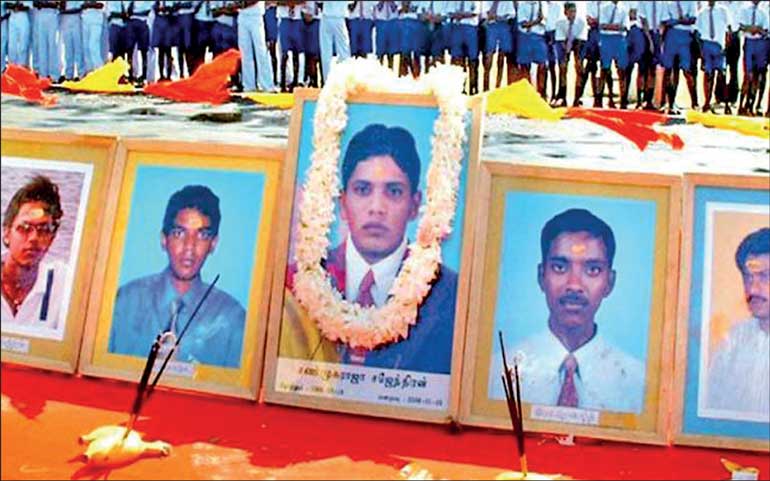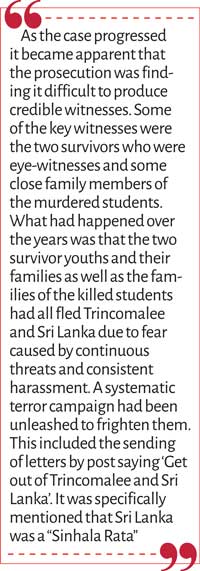Monday Jan 19, 2026
Monday Jan 19, 2026
Wednesday, 5 January 2022 00:20 - - {{hitsCtrl.values.hits}}

Thus ended the Trinco 5 case without anyone being convicted due to insufficient evidence. However, the Trinco 5 case continues to be cited as an emblematic case of impunity in Sri Lanka
A solemn, low-key memorial event was held in Trincomalee town on Sunday, 2 January. Relatives and friends laid flowers and lit candles and lamps in memory of five Tamil youths killed in Trincomalee town on 2 January 2006. The incident that happened 16 years ago for which justice was not done is widely known among human rights circles as the “Trinco 5” case of Sri Lanka.
friends laid flowers and lit candles and lamps in memory of five Tamil youths killed in Trincomalee town on 2 January 2006. The incident that happened 16 years ago for which justice was not done is widely known among human rights circles as the “Trinco 5” case of Sri Lanka.
It is regarded as an emblematic case of impunity. So much so that the UN High Commissioner for Human Rights Michele Bachelet mentioned the incident under the section on “Impunity in emblematic cases” in her annual report to the UN Human Rights Council in March 2021. The relevant excerpt is as follows:
“In previous reports to the Human Rights Council, OHCHR has tracked the investigation and prosecution of emblematic cases as a key measure of Sri Lanka’s commitment to ending impunity. These include the killing of five Tamil students in Trincomalee and of 17 humanitarian workers in Muttur in 2006; the assassination of journalist Lasantha Wickrematunge in 2009; the disappearance of journalist Prageeth Eknaligoda in 2010; the killing of protestors by army personnel during a demonstration at Weliweriya in August 2013; the anti-Muslim riots in Aluthgama in 2014 and Digana, in 2018, as well as others. Despite investigations over the years by domestic Commissions of Inquiry and the police, and the arrest of some suspects and trials at bar, not a single emblematic case has been brought to a successful conclusion or conviction.”
What then is the Trinco 5 case and why has justice not been done so far? The killing of five Tamil students and the injuring of two others in Trincomalee is an incident about which I have written before. In fact, it was I who first wrote extensively about it in an English newspaper in January 2006. I shall therefore revisit the incident and subsequent developments relying on some of my earlier writings.
Five Tamil students were killed near the beach in Trincomalee town 16 years ago on 2 January 2006. Two other students also suffered injuries but survived. The names and the dates of birth of the five victims were: (i) Manoharan Ragihar – 22.09.1985, (ii) Yogarajah Hemachchandra – 04.03.1985, (iii) Logitharajah Rohan – 07.04.1985 (iv) Thangathurai Sivanantha – 06.04.1985, and (v) Shanmugarajah Gajendran – 16.09.1985. The two injured youths were Yogarajah Poongulalon and Pararajasingham Kokulraj.
The official version put out first was that all seven were members of the Liberation Tigers of Eelam (LTTE) who had been armed with grenades with the intention of attacking a security forces post. The grenades had exploded accidently killing five and injuring two. But the initial claim was soon proved wrong. The post-mortem conducted by Dr. Gamini Gunatunga, the Judicial Medical Officer in Trincomalee, determined that the five had died from gunshot wounds. Three had been shot in the head at close quarters, while two died from shots to the chest and abdomen. Some had injuries that were not caused by gunshots. The Trincomalee Magistrate V. Ramakamalan conducted a magisterial inquiry and recorded an interim verdict of gunshot injuries.
Reliable reports in the media as well as by reputed human rights organisations pointed the finger at sections of the security forces stationed in Trincomalee. The war against the LTTE was being renewed and fought at that time. On 12 February 2006, some members of the Police and Special Task Force (STF) were taken into custody in connection with the killings. However, they were released in April that year for want of tangible evidence. The then Attorney-General, C.R. de Silva issued a directive then that the case should be pursued again if the Prosecution acquired fresh evidence.
The Sri Lanka Human Rights Commission then chaired by Dr. Radhika Coomaraswamy appointed former High Court Judge T. Sundaralingam as a special rapporteur to probe the killings. His report was submitted on 31 March 2006 to the HRC. The report was not publicised due to some procedural hassles and transitionary issues at the HRC. The HRC Chairperson Dr. Coomaraswamy’s term of office too had ended on 31 March 2006 and she flew to New York that night to take up her new post as UN under-secretary in charge of children in armed conflict. Since the report could not be released unilaterally by the chair and required the full approval of the commission Dr. Coomaraswamy had left it in her “hand over docket” for her successors for follow up action.
Sri Lanka’s president at that time was Mahinda Rajapaksa. Unfortunately, Mahinda Rajapaksa who had been a human rights activist during the UNP regimes of J.R. Jayewardene and R. Premadasa, had changed track after becoming President in 2005. The human rights commission was given step-motherly treatment and many of the appointments made to the HRC left much to be desired. Gradually the HRC became highly politicised and lost its lustre and effectiveness during the Mahinda Rajapaksa period. The Sri Lankan Human Rights Commission suffered great loss of prestige when it was reclassified into Category ‘B’ from that of ‘A’.
One of the casualties during the dark days of the HRC was the Sundaralingam report. The “official” fate of that report remained a mystery for many years. Subsequently extracts of the report were quoted by Human Rights Organisations and activists in their writings but there was no official release of the report.
Things changed after the regime change in 2015. Dr. Deepika Udagama was appointed HRC chair in October 2015 after the Constitutional Council was renewed and reinvigorated by the Maithripala Sirisena-Ranil Wickremesinghe Government. The HRC regained much of its eroded respect under the new dispensation and was restored to ‘A’ status after a few years. Among the achievements of the HRC headed by Dr. Udagama was the release and publication of Special Rapporteur Report by Judge T. Sundaralingam in March 2016.
“We know the STF did it, but the bullet and gun evidence, shows that they did not”
Interestingly enough a “Wikileaks” report that came to light some years ago referred to a US state dept cable in October 2006. According to Wikileaks, Mahinda’s sibling Basil Rajapaksa who was a special adviser to the president at that time had admitted to the US ambassador Robert O. Blake (jnr.) that the STF was responsible for the killings and that there was no evidence to convict them. The Wikileaks report of the State department cable quoted Basil Rajapaksa as saying, “We know the STF did it, but the bullet and gun evidence shows that they did not. They must have separate guns when they want to kill someone.”
STF was responsible for the killings and that there was no evidence to convict them. The Wikileaks report of the State department cable quoted Basil Rajapaksa as saying, “We know the STF did it, but the bullet and gun evidence shows that they did not. They must have separate guns when they want to kill someone.”
The war against the Liberation Tigers of Tamil Eelam (LTTE) ended in 2009 with the military defeat of the tigers. Riding the crest of a wave of war victory euphoria, Mahinda Rajapaksa was re-elected president in 2010. President Mahinda Rajapaksa appointed the Lessons Learnt and Reconciliation Commission (LLRC) in May 2010. It was chaired by former Attorney-General C.R. de Silva known popularly as “Bulla’ since his rugby playing days at Royal College. The LLRC submitted its report to President Rajapaksa in November 2011 after the mandated 18-month period. Among its observations pertaining to the Trincomalee student killings was the following: “There are strong grounds to surmise the involvement of uniformed personnel in the commission of the crime.” There was no follow up action by the President on the LLRC report then.
The reluctance displayed by the Rajapaksa regime in addressing issues of accountability and reconciliation led to increasing pressure by the “international community” on the Government. International human rights organisations played a crucial role in helping to sustain this momentum. One of the cases taken up by human rights activists was the killing of the Trincomalee students referred to in those circles as the Trinco 5 case. The families of the murdered Trincomalee students who had fled Sri Lanka in the aftermath of the killings due to intimidation and harassment cooperated with the human rights activists to spotlight the lack of concrete legal action against suspected perpetrators.
The UN Human Rights Council sessions in March 2013 in Geneva was a watershed of sorts. Two of the parents concerned, Dr. Kasipillai Manoharan, the father of Ragihar, and Aiyamuttu Shanmugarajah, the father of Gajendran, were in Geneva during the UNHRC sessions and participated in several meetings and conferences held on the sidelines. They pointed out that no action had been taken for seven years. Their impassioned pleas demanding justice for their children made a profound impact in Geneva. To his credit the then plantation industries minister Mahinda Samarasinghe who was in Geneva leading the Lankan delegation at the UNHRC returned to Sri Lanka and pressed for an investigation and follow up action. Thereafter the CID recommenced its probe.
With the CID probe in progress, former foreign secretary Ravinatha Aryasinha who was then Sri Lanka’s permanent representative at the UN in Geneva addressed the UNHRC Regular session in May 2013. During the course of his address, Aryasinha stated as follows: “Pursuant to recommendations made by the LLRC, in relation to the killings of the five students in Trincomalee, investigations have been concluded and upon studying the material, the Attorney General has advised the Police to initiate non-summary proceedings, and the formal institution of these proceedings before the Trincomalee Magistrate is due to take place in the first week of June.”
On 4 July 2013, 12 Special Task Force (STF) personnel and a Police officer were arrested and produced in courts the following day. The 12 STF officers were Inspectors Sarath Chandra Perera and Rohitha Vijithakumara, Sgt. M.G. Jayalath, Sgt. A.P. Amal Pradeep, Constables S.R.K. Ratnayake, M. Chaminda Lalitha, R.M. Udhaya Mahinda Bandara, M.G.H. Sanjeewa, K.A. Tharaka Ruwansiri, J.M. Nimal Bandara, J.M. Senarath Dissanyake and S.J. Indika Thushara of the STF. The Police Officer was Sub-inspector P.G. Ananda Bulanawewa. On 14 October 2013 they were all released on bail. The case however proceeded in fits and starts.
The 13 accused were charged by the CID under Section 296 of the Penal Code for committing the murder of Manoharan Rajiharan, Yogarajah Hemachandra, Lohitha Raja Rohan, Thangadorai Sivanathan and Sammugarajah Gajendran by shooting near the Gandhi roundabout on 2 January 2006 and the attempted murder of Yogarajah Poongulalon and Pararajasingham Kokulraj under Section 300 of the Penal Code read with section 32. The CID had submitted seven productions to court in this connection and cited 36 witnesses.
Credible witnesses
As the case progressed it became apparent that the prosecution was finding it difficult to produce credible witnesses. Some of the key witnesses were the two survivors who were eye-witnesses and some close family members of the murdered students. What had happened over the years was that the two survivor youths and their families as well as the families of the killed students had all fled Trincomalee and Sri Lanka due to fear caused by continuous threats and consistent harassment. A systematic terror campaign had been unleashed to frighten them. This included the sending of letters by post saying ‘Get out of Trincomalee and Sri Lanka’. It was specifically mentioned that Sri Lanka was a “Sinhala Rata”.
The families of the victims had therefore left the land of their birth one by one. They were now safe in foreign countries and were not prepared to return to Sri Lanka and testify in a Trincomalee court. Moreover, there was palpable fear among the people of Trincomalee to come forward and testify too. Over a hundred persons including vendors, people on the beach, passers-by, auto rickshaw drivers and curious onlookers had witnessed the incident in different degrees. However, none was ready to say anything due to intimidation and fear. Contributing to this state of fear was the fate of a Tamil three-wheeler driver and photojournalist. Some days after the killing of the Trinco 5, they were both killed by “unknown” persons. The three-wheeler driver was an eye witness to the incident and had been prepared to testify in a trial. The journalist had reportedly published incriminating photographs of the victims showing they had been shot dead point blank.
This state of affairs where key witnesses were reluctant to give evidence in a Sri Lankan court was sought to be remedied by the new government of 2015 headed by President Sirisena and Prime Minister Wickremesinghe. The “Assistance to and Protection of Victims of Crime and Witnesses Act” was passed in 2015, and later amended in 2017, These measures enabled witnesses to testify by skype from a Sri Lankan diplomatic mission abroad. The witnesses concerned were in Australia, Europe and North America.
The prolonged legal delay even after the advent of the new Government prompted former US envoy Atul Keshap to tweet about it in January 2018 and reiterate that “Justice delayed is justice denied”. The then Law and Order Minister Sagala Ratnayake responded to it by tweeting that the case was progressing after the legal reforms. “We could not proceed with the case as the main witness was overseas and was not in a position to support proceedings. The case is now progressing as new reforms have allowed the use of Skype evidence,” Sagala Ratnayaka said on Twitter in January 2018.
In spite of well-intentioned action by the Yahapalanaya Government to proceed with the case, the reluctance of the key witnesses to testify persisted. They continued to keep refusing. Dr. Kasipillai Manoharan refused to give evidence via Skype and instead asked that evidence be recorded using satellite technology. There was also opposition to the idea of going to a Sri Lankan diplomatic mission and testifying by Skype. The position taken up by the potential witnesses was endorsed by reputed human rights organisations such as the Amnesty International (AI).
A news report in a Colombo newspaper published in January 2019 stated as follows: “Amnesty International said that a witness can only provide evidence to a diplomatic mission of Sri Lanka, which was unacceptable. Justice for the students murdered over 13 years ago still eludes their loved ones and given the difficulties in securing witness testimonies, the Trinco 5 case has seen little to no progress in the most recent past. The Assistance to and Protection of Victims of Crime and Witnesses Act was passed in 2015, and later amended in 2017, enabling witnesses to give evidence from outside Sri Lanka. However, the fact that a witness can only provide such evidence at a diplomatic mission of Sri Lanka means that a witness may face intimidation. The safety of a diplomatic mission is not sufficient for a victim to give evidence, especially in this case where levels of intimidation were so high,” Research, Campaigns, and Communications Assistant at Amnesty International Rehab Mahamoor told “The Sunday Morning”.
It was against this backdrop therefore that the Trincomalee Five case progressed. After lengthy legal proceedings, the curtain descended on 3 July 2019. Eight of the 36 witnesses cited had not been heard by court as they had not made themselves available to testify. These included key witnesses including two surviving eye witnesses. Courts was told that the two key survivor eye-witnesses reportedly living abroad were unreachable and untraceable.
After some hearings in 2013/14 where several witnesses testified, proceedings dragged on thereafter without any tangible fresh evidence being provided. Dates were set and reset and proceedings postponed for umpteen times without witnesses being presented. In fairness to the Attorney-General’s Department, its officials tried very hard to persuade the witnesses to turn up and present themselves in court with full protection or testify via Skype from abroad. Lawyers appearing for the defence were very patient and cooperated fully with the prosecution by not protesting against the long delay. The case dragged on for more than five years without any positive forward movement. It was heard by three different Magistrates during this period.
Finally, Trincomalee Chief Magistrate M.M. Mohammed Hamza on 3 July 2019 acquitted all 13 accused of all charges. The Magistrate after considering the evidence ruled that the accused be released due to non-availability of sufficient evidence to continue the case in a satisfactory manner. Additional Solicitor General Dilantha Rathnayake prosecuted and Attorneys Dhanushka Madagedara and S. Chandrasiri appeared for the defence until the last stages of the case. Thus ended the Trinco 5 case without anyone being convicted due to insufficient evidence. However, the Trinco 5 case continues to be cited as an emblematic case of impunity in Sri Lanka.
(This is a modified version of an earlier article.)
(The writer can be reached at [email protected].)